
The Light Street Roundabout marks the eastern end of Light Street, the first street in George Town.
Light Street, in the heart of George Town UNESCO World Heritage Site, was the first ever street to be laid out in George Town. The street now forms the core civic precint in the city, with many administrative buildings built along it since the heyday of British rule.
Light Street was laid out after Captain Francis Light, the founder of George Town, had encouraged immigrants to clear the jungles by firing silver dollars from the cannons on his ship, forming The Esplanade. The first street in George Town was named after himself, and all other streets in George Town since then were laid out from Light Street.
Aside from Light himself, the street was initially occupied by British administrators, East India Company soldiers and policemen. After Penang Island, then named the Prince of Wales Island, was granted the status of the Presidency of India in 1805, grander administrative buildings began to be constructed along the street.

A multilingual Light Street sign. Light Street is translated as Lebuh Light in Malay.
To this day, Light Street serves as the administrative centre of Penang Island and the core of George Town's civic precint, similar to the Civic District in downtown Singapore. The colonial administrative buildings along Light Street are among the most impressive and recognisable landmarks on Penang Island. While Western architectural styles, ranging from Anglo-Indian to Palladian, dominate the street, there is also the recently-renovated Penang Chinese Chamber of Commerce, as well as more modern office blocks.
The relatively straight street runs in the east-west direction, from Farquhar Street to the west to the eastern Light Street Roundabout, which connects with Beach Street, King Edward's Place and Jalan Tun Syed Sheh Barakbah.
Etymology[]
Light Street was named after Captain Francis Light, the founder of George Town. It was a befitting honour, as Light Street was the very first street to be laid out in the city.
The street is also called Po3 Le3 Khau3 ('Gate to the Police Station' in Hokkien) because the State Assembly Building at Light Street was was once used as part of the Central Police Station. The term Po3 Le3 is a Hokkien corruption of the word 'police'.
History[]
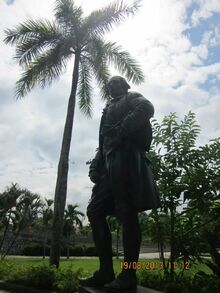
A statue of Captain Francis Light, the founder of George Town, still stands inside Fort Cornwallis on the spot where he first landed on 17 July 1786.

The Padang at The Esplanade was created when Light ordered the clearing of the jungles using silver dollars fired from his ship.
After Captain Francis Light, the founder of George Town, first landed on what is now Fort Cornwallis on 17 July 1786, he ordered the crew of his ship to fire silver dollars from the ship's cannons into the jungle. It was said that the move was intended to encourage immigrants to clear the jungle. This also led to the creation of a clearing, to be known later as The Esplanade.
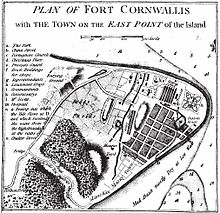
An old map of George Town. Light Street ran horizontally in the east-west direction just south of Fort Cornwallis and The Esplanade.
After the jungles had been cleared, Light named the first street of George Town after himself. Subsequently, all other streets in George Town were laid out from Light Street. Therefore, Light Street was the nucleus out of which George Town expanded, and is older than most cities within the Malay Peninsula, including Singapore and Kuala Lumpur. This street is relatively straight and runs in the east-west direction.

Fort Cornwallis was built by Captain Francis Light and completed in 1810.
Light and his business partner, James Scott, then had their residences built along Light Street. Light also constructed a jetty at the eastern end of Light Street and a well for the new settlement of George Town at the western end of the street. Both structures are now long gone; the jetty was removed when land was reclaimed to the east of Light Street to build Swettenham Pier. Also, despite having no military experience, Light had a simple wooden stockade built for defensive purposes near the eastern end of Light Street, coincidentally on the spot where he first landed. The stockade was gradually built up into the Fort Cornwallis we see today.
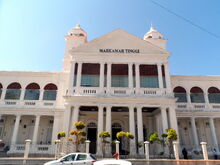
The Supreme Court of Penang was relocated from Fort Cornwallis to its present premises at Light Street in 1809. The Palladian-style building it now occupies was inaugurated in 1903.
Aside from Light and Scott, the street was initially occupied by British administrators, East India Company soldiers and policemen. After the Prince of Wales Island, as Penang Island was named then, was made the Fourth Presidency of India in 1805, grander administrative buildings began to be constructed along the street, such as the State Assembly Building. The Supreme Court of Penang, which had been established inside Fort Cornwallis in 1808, was subsequently relocated to its present premises at Light Street. Meanwhile, a convent was established in 1852 by French Catholic nuns; it was moved to Light Street in 1859, becoming the Convent Light Street.
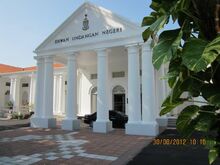
The Anglo-Indian classical styled State Assembly Building was built in the 1820s. It now serves as the 'Parliament' for the State of Penang.
By the mid-19th. century, Chinese millionaires began to acquire properties along the once-exclusively European street. As land usage rules continued to be relaxed, Chinese millionaires like Foo Tye Sin also had their residences built along Light Street. In 1928, the Penang Chinese Chamber of Commerce was constructed at Light Street.

The Dewan Sri Pinang auditorium at Light Street
The Light Street Roundabout did not came about until after the Second World War. Previously, Light Street, Beach Street, King Edward's Place and Fort Road (now Jalan Tun Syed Sheh Barakbah) met at the junction on which the roundabout is located. To this day, the roundabout marks the eastern end of Light Street.
Later in the 20th. century, the Dewan Sri Pinang auditorium and a few office blocks, including the Penang branch of the Malaysian central bank (Bank Negara Malaysia), were added along Light Street.

The Logan Memorial opposite the Supreme Court of Penang was erected in honour of James Richardson Logan, a Scottish lawyer who fought for the rights of Asians in British Penang.
Notable Landmarks[]

The Penang Chinese Chamber of Commerce has recently underwent extensive renovation works.
From west to east :
- Convent Light Street
- Supreme Court of Penang
- Logan Memorial
- Dewan Sri Pinang
- Municipal Fountain
- Chung Siew Yin Building
- The Esplanade
- Penang Chinese Chamber of Commerce
- Foo Tye Sin Mansion
- State Assembly Building
- Fort Cornwallis
- Immigration Department Building
- Jubilee Clock Tower
- Pinang Fountain (Light Street Roundabout)
Financial Institutions[]
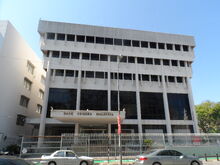
The Malaysian central bank (Bank Negara Malaysia) at Light Street
From west to east :
- Bank Negara Malaysia
- Country of Origin : Malaysia
- Great Eastern Life Assurance Co. Ltd.
- Country of Origin : Singapore
- Hong Leong Bank
- Country of Origin : Malaysia
- Affin Bank
- Country of Origin : Malaysia
Educational Institutions[]
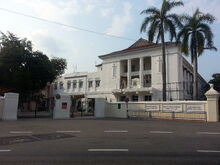
Convent Light Street, the oldest girls' school in Southeast Asia
Convent Light Street is the oldest girls' school in Southeast Asia. It was initially founded at Church Street by French Catholic nuns of the Holy Infant Jesus Mission in 1852, before moving to Light Street in 1859. It was once a boarding school for the elite, including the Thai royal princesses. Today, the historic girls' school is one of the most well-known missionary schools on Penang Island.
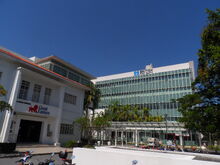
The British Council (right) and the Chung Siew Yin Building (left), now occupied by the Great Eastern Life Assurances Co. Ltd., at Light Street
The British Council also set up its Penang branch at Light Street, west of the Chung Siew Yin Building which houses the Great Eastern Life Assurance Co. Ltd.
Art Pieces[]
The Pinang Fountain was erected on the Light Street Roundabout in the early 2000s. The betel nut-shaped fountain initially came under intense criticism from local Penangites, who believed it was an eyesore. However, it is now accepted as part of the landscape of the roundabout; most Penangites surveyed also found it to be attractive at night, when colourful lighting lights up the fountain.

Light Street, near the newly-opened The Chambers Hotel.
Hotel[]
The Chambers Hotel
Political Representation[]
Penang State Government[]
N.26 Padang Kota State Assemblyman : Chow Kon Yeow (Democratic Action Party)
Malaysian Federal Parliament[]
P.049 Tanjong Member of Parliament : Ng Wei Aik (Democratic Action Party)
References[]
- Langdon, M. A Guide to George Town's Historic Commercial and Civic Precints. Penang : George Town World Heritage Incorporated.
- Hockton, K., Howard Tan, 2012. Penang : An Inside Guide to Its Historic Homes, Buildings, Monuments and Parks. MPH Group, Kuala Lumpur.
- http://www.penang-traveltips.com/light-street.htm